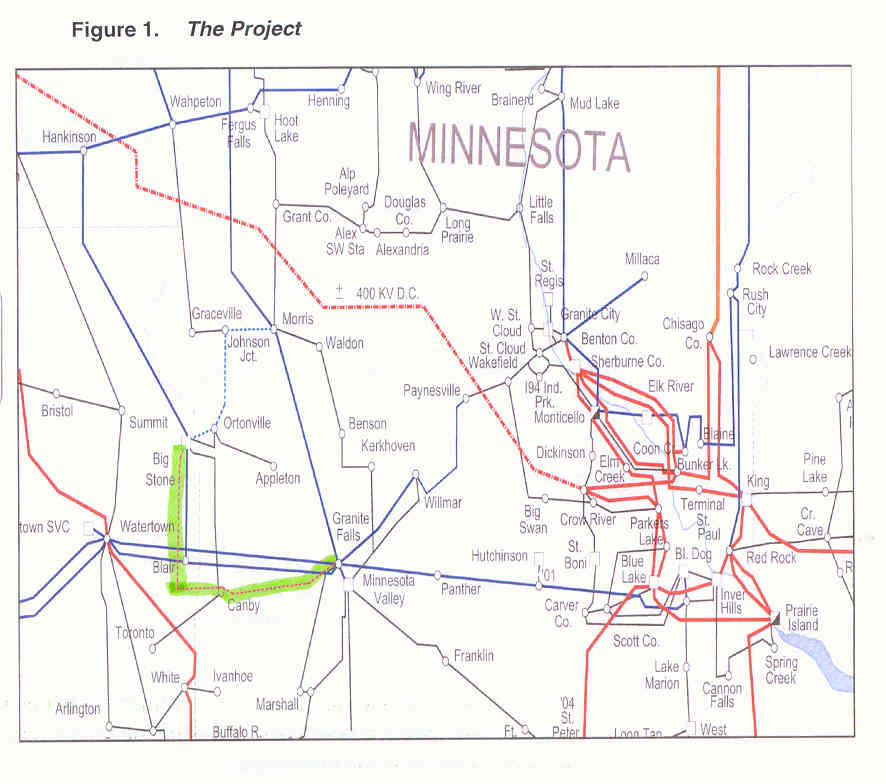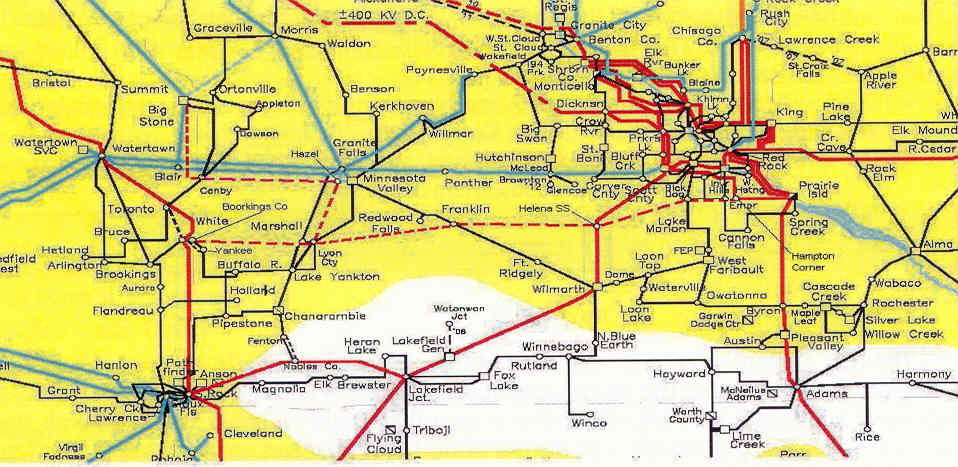BS II – the line to nowhere
November 27th, 2005

See the part highlighted in green? That’s the Big Stone II transmission project as applied for — see why I call it BS II? It’s a line from the plant to the middle of nowhere (no offense to Granite Falls!). As the industry is so busy explaining to us, the grid is an interconnected system. A line from somewhere to nowhere, a radial line like this one, according to the industry, is a reliability risk, it’s not stable. Yet that’s what they want to do, run a big line to nowhere. Uh-huh, yup, sure…
Oh, but there’s more — as they say in the BS II Application, p. 3:
When operated at 345kV, the Granite Falls line will act as the first phase of a 345kV transmission plan connecting western/southwestern Minnesota to the Twin Cities.
Well, DUH, we know it’s all connected. Here’s what they’re building looks like, in toto:

The red dashed line is the entire project, a system, as the application states. Without the entire project, BS II electricity doesn’t get where they want it to go.
How does MTEP06 describe this segment? Look at section 6.1, point 2:
2. Belfield, North Dakota (site of a new 500 MW coal plant) to Ellendale, South
Dakota to Big Stone area to Granite Falls to Blue Lake, Minnesota
… let me see if I understand the MTEP plan, the Belfield’s connected to the Big Stone, the Big Stone’s connected to the Granite Falls, the Granite Falls’ connected to the Blue Lake… and we’re at the MNEX electrical turnabout to shoot electricity out to the east and south!
… now this BS II Application… let me see if I understand the BSII Application… The Big Stone’s connected to the Granite Falls… CONNECTUS INTERRUPTUS! DUH, something’s missing…
**************************************************************
December 1 is the PUC meeting on the completeness of the Big Stone II transmission line.
Here’s the Staff Briefing Papers, and here’s their summary of my Comments:
Initial Comments of Carol A. Overland
Carol Overland argued that the Application in not complete in at least three major respects:
The entire project is not described. A 345-kV line does not go from a large power plant to the middle of nowhere. The 345-kV line is a part of a much larger project, including the Belfield, North Dakota coal plant and continuation of the line to the Twin Cities area.
There is no explanation of how the power gets to the utilities who are claiming need. There must be a demonstration of how the project, or an expanded project, fulfills the need claimed for electricity.
Any deals that have been made relevant to this project must be included. A South Dakota newspaper alluded to certain deals to benefit wind power. Relevant deals must be filed with the Commission and scrutinized for impacts beyond the parties.
And here’s what BSII has to say about that:
In response to the comments of Carol A. Overland, the Applicants indicated:
There is absolutely no precedent in law–or in how the system operates–for the
Commission to delay action on this proceeding in order to wait for additional facilities
that might be proposed later. While Applicants and other utilities are working toward
proposing other 345-kV facilities, the proposed project remains a stand-alone project.The Application is ripe with data and information on how the proposed project meets the
Applicants’ needs and is consistent with state energy policy. Her comments seem directed
at the merits of the project rather than completeness of the Application.Applicants are unaware of any current “deal”; the issue is irrelevant to Application
completeness in any case.
Hmmmmmmmm… it’s billed in the CapX2020 Sept. 6, 2005, announcement of the Phase I transmission projects as a unit, a system, several smaller projects that are all connected… yet they call it a “stand alone project.” BSII
They want this project to meet certain needs of certain utilities, but do not explain how a line to Granite Falls will do anything for any of those utilities. That’s BSII
Deals to allow the coal plant and transmission to proceed are irrelevant to Application completeness? That’s BSII !!
Here’s what PUC staff says:
Second, staff agrees with the Organizations and the Applicants that the concerns raised by Carol A Overland are not completeness issues. This does not mean, however, that the concerns she raised are inappropriate for the hearing process.
Hearing process? That assumes an ability to participate in a Contested Case hearing — that’s a BIG deal — who’s paying for that? Where are the resources that enable a reasonably thorough level of participation? Essentially, what this says is that if I do not Intervene, these issues will not be addressed.

Leave a Reply